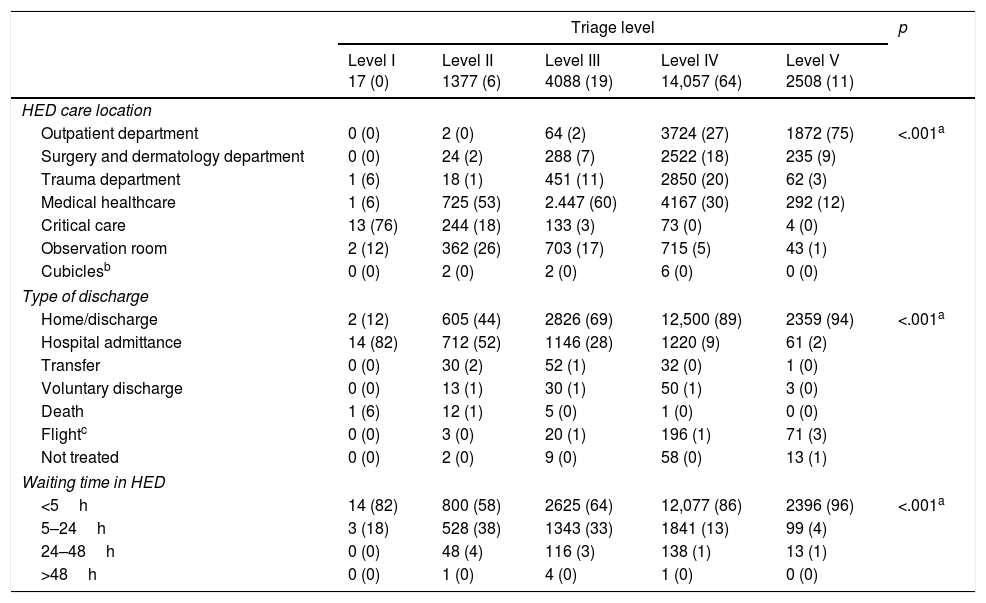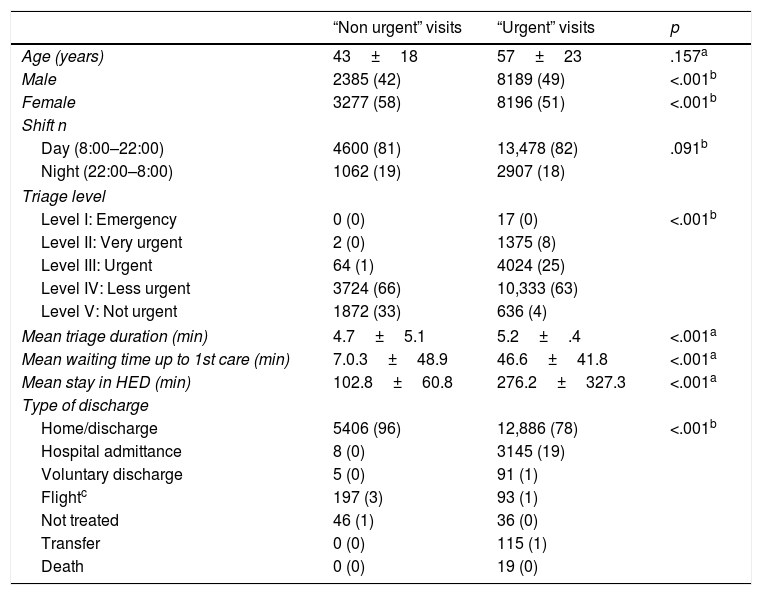To evaluate nurses’ triage quality and adequacy in Saragossa's Hospital Clínico and to compare the main characteristics of “urgent” and “non-urgent” visits to the Hospital Emergency Department (HED).
MethodThis exploratory-retrospective research study was carried out over the last 3 months of 2015 (paediatrics, gynaecological and ophthalmologic emergencies were excluded). Data were obtained from the “Puesto Clínico Hospitalario” programme used in the HED. The quality of the triage performed by nurses was assessed using the 4 indexes proposed by Gómez Jimenez and the adequacy of patient classification was established by relating the level of triage assigned with the place of care, length of stay in the HED and type of discharge. Differences between “non-urgent” (seen in outpatient consultations of the HED) and “urgent” visits were analysed.
Results22,047 individuals were included. Quality indices relating to waiting times were not fully met. Higher severity of triage was associated with being attended in the area of Vital and Medical Care, a longer stay in the HED and a higher proportion of hospital admissions (p<.001), so that triage performed by nursing is considered adequate. “Non-urgent” visits obtained less severity of triage, a shorter stay in HED and a greater proportion of hospital discharges (p<.001).
ConclusionsNursing triage needs to improve quality aspects related to waiting times but is appropriate enough as it discriminates between place of care and type of discharge for each level of triage within the desirable limits.
Evaluar la calidad y la adecuación del triaje realizado por enfermeras en el Servicio de Urgencias Hospitalarias (SUH) del Hospital Clínico Universitario de Zaragoza y comparar las características de las visitas «urgentes» y «no urgentes» detectadas.
MétodoEstudio descriptivo-retrospectivo de las visitas del último trimestre de 2015 (pediátricas, ginecológicas y tocológicas, y oftalmológicas excluidas) a partir de los datos del programa Puesto Clínico Hospitalario del SUH. La calidad del triaje realizado por enfermeras se evaluó con los 4 índices propuestos por Gómez Jiménez y la adecuación de la clasificación de los pacientes se estableció relacionando el nivel de triaje asignado con lugar de atención, tiempo de estancia en el SUH y tipo de alta. Se analizaron las diferencias entre las visitas «no urgentes» (atendidas en consultas ambulatorias del SUH) y las visitas «urgentes».
ResultadosSe incluyeron 22.047 individuos. Los índices de calidad relacionados con los tiempos de espera no se cumplen en su totalidad. Mayor gravedad de triaje se asocia con ser atendido en el área de Vital y Atención Médica, mayor tiempo de estancia en el SUH y mayor proporción de ingresos hospitalarios (p<0,001) por lo que el triaje realizado por enfermeras se considera adecuado. Las visitas «no urgentes» obtienen menor gravedad de triaje, menor estancia en el SUH y mayor proporción de altas hospitalarias (p<0,001).
ConclusionesEl triaje realizado por enfermeras necesita mejorar aspectos de calidad relacionados con los tiempos de espera pero es suficientemente correcto ya que discrimina lugar de atención y tipo de alta para cada nivel de triaje dentro de lo deseable.








